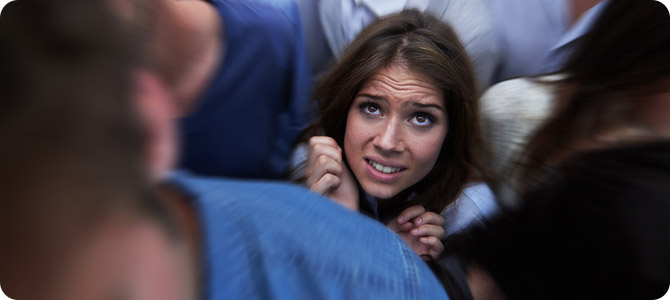Claustrophobia vs. Agoraphobia: Understanding the Differences
At Psychiatry of the Palm Beaches, we help patients understand the key differences between claustrophobia and agoraphobia. Dr. David Husted and our team offer personalized treatment plans to address these anxiety disorders effectively. Our compassionate approach supports your journey to improved mental health. For more information, contact us or book an appointment online. Visit Psychiatry of the Palm Beaches serving Jacksonville, Boynton Beach, Palm Beach Gardens, Stuart, Royal Palm Beach, Port St. Lucie, Melbourne, Fort Lauderdale, and Jupiter, FL.


Table of Contents:
What is the difference between claustrophobia and agoraphobia?
What causes agoraphobia, and how is it different from claustrophobia?
Can someone have both claustrophobia and agoraphobia?
Is claustrophobia caused by the fear of being in tight spaces?
There are a number of phobias involving space and location, including claustrophobia and agoraphobia. While both involve fear that restricts movement or daily activity, the underlying triggers and patterns often differ. Individuals may find themselves avoiding specific environments or situations, either due to the sensation of being trapped or the fear that escape won’t be possible in the event of panic. These conditions can have a number of adverse impacts on everyday life, limiting work, travel, or even routine errands. Treatment at Psychiatry of the Palm Beaches focuses on identifying those responses and helping individuals reclaim a sense of safety and freedom in the spaces they once avoided.
Claustrophobia typically refers to the fear of enclosed or tight spaces. A small, cramped, or crowded space can trigger a strong physical and emotional response, often involving rapid breathing, dizziness, or an overwhelming urge to escape. The anxiety is tied to the space itself and the sensation of being restricted or unable to get out quickly. That sense of physical confinement is usually at the center of the reaction, even when the space is objectively safe.
Agoraphobia tends to develop around the fear of being in places where escape might feel difficult during a panic episode. This could include wide open spaces, public transportation, busy areas, and more. While it differs from claustrophobia, they both present with similar feelings of anxiety around feeling trapped or unable to get help. It isn’t necessarily the space itself that causes the distress, but the internal distress pertaining to how one might manage if anxiety becomes overwhelming while there.
The distinction lies in what triggers the fear and how the brain interprets danger in those moments. Claustrophobia is more sensory, rooted in spatial discomfort, while agoraphobia is more shaped by the fear of panic without an easy exit. Specialists at Psychiatry of the Palm Beaches approach each condition based on how it presents in the individual, understanding that fear often takes shape in complex ways that are personal rather than universal.
Agoraphobia often starts with panic attacks that feel unpredictable or intense. After experiencing one or more of these episodes in public settings, individuals may begin to associate certain environments with the possibility of having another attack. Over time, avoidance becomes a coping strategy. A place once visited without thought can suddenly feel unsafe, not because of the location itself, but because of the imagined loss of control that might occur there. Unlike claustrophobia, which usually centers on physical tightness or restricted movement, agoraphobia builds around the fear of being unable to escape or access support during a wave of anxiety. It may include a range of settings rather than one consistent trigger. A person might avoid driving on the highway, walking into a crowded movie theater, or even stepping outside the home alone. The behavior is inspired more by what the location represents in the mind than it is the location itself.
At Psychiatry of the Palm Beaches, the goal is to help the individual gradually separate the fear from the environment and rebuild a sense of mobility and confidence. While the path to progress may look different for agoraphobia than for claustrophobia, both conditions respond well to structured, supportive treatment when the focus remains on realigning the emotional and physical experience of safety.
It’s not uncommon for claustrophobia and agoraphobia to overlap, especially when the individual has a heightened sensitivity to feelings of confinement, vulnerability, or lack of control. Someone might avoid elevators due to claustrophobia, but also fear being far from home due to agoraphobia. Each fear has its own logic, but they may feed into each other, reinforcing a cycle of restriction that gradually shrinks the individual’s comfort zone. When both phobias are present, the emotional consequences tend to be even more significant. A person may feel cornered by their own avoidance, unable to find a safe space, either because it’s too enclosed or too exposed. That can increase anxiety and make daily planning exhausting. It also adds complexity to treatment, as triggers may need to be addressed in layers rather than all at once.
Providers at Psychiatry of the Palm Beaches work to untangle those layers without overwhelming the patient. Treatment is shaped by a deep understanding of how fear manifests across different contexts and how those patterns can shift when given the right support. Even when both phobias exist together, recovery is possible with the right pace, patience, and guidance.
Claustrophobia usually stems from the fear of being trapped or suffocated rather than the space itself. A small room might not cause distress on its own, but once the individual perceives threats like a lack of exit or airflow, the response can become overwhelming. That reaction is often tied to early experiences or moments where the person felt powerless in a confined setting. Over time, the brain begins to associate similar environments with that initial sense of panic.
The physical symptoms that show up during a claustrophobic episode can feel intense and can include shortness of breath, heart palpitations, sweating, and the sudden urge to escape. These are signs that the nervous system is reacting to perceived danger, even when the setting poses no actual threat. The fear becomes less about logic and more about the automatic response that kicks in once the space feels too small or inescapable.
The specialists at Psychiatry of the Palm Beaches approach claustrophobia by focusing on the external triggers as well as the internal associations the person has built over time. With the right support, patients can learn to reinterpret those sensations and gradually return to spaces they once avoided.
Claustrophobia and agoraphobia treatment are available at Psychiatry of the Palm Beaches. For more information, contact us or book an appointment online. We have convenient locations to serve you. We serve patients from Boynton Beach FL, Delray Beach FL, Palm Beach Gardens FL, Jupiter FL, Stuart FL, Palm City FL, Royal Palm Beach FL, Wellington FL, Citrus Ridge FL, Jacksonville FL, Riverside FL, Port St. Lucie FL, Beau Rivage West FL, Melbourne FL, Palm Bay FL, Fort Lauderdale FL, Hollywood FL, Jupiter FL, North Palm Beach FL, and surrounding areas.
Check Out Our 5 Star Reviews



Additional Services You May Need
▸ Mental Wellness
▸ Relationship Coaching
▸ Depression and Mood Disorders
▸ Women’s Health
▸ Panic Disorder
▸ Medications Management
▸ Men’s Health
▸ Individual Psychotherapy
▸ Bipolar
▸ ADHD
▸ Geriatric Mental Health
▸ Couple’s Counseling
▸ Obsessive Compulsive Disorder
▸ Social Phobia Treatment
▸ Eating Disorders
▸ Post Traumatic Stress Disorder
▸ Psychotic Disorders


